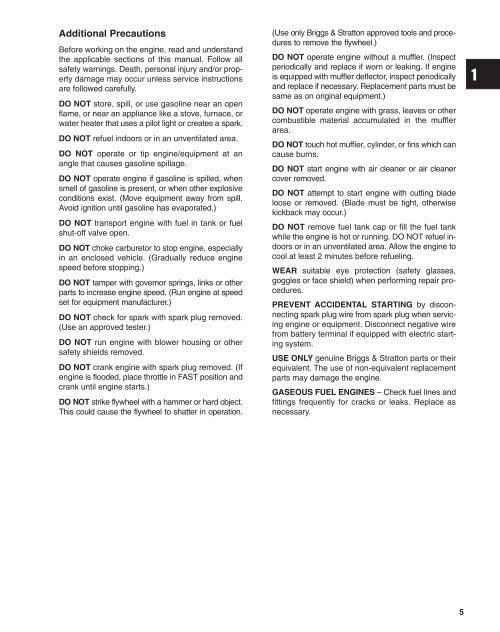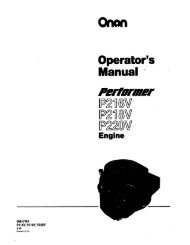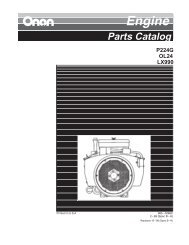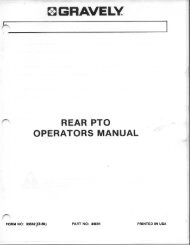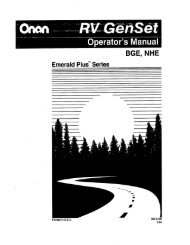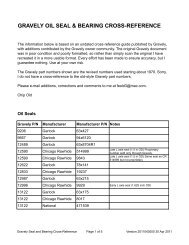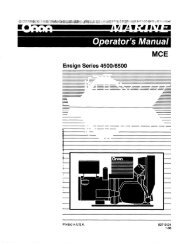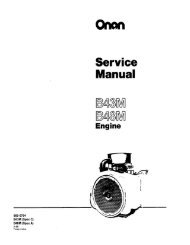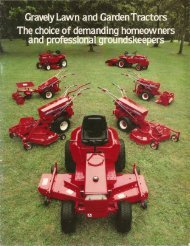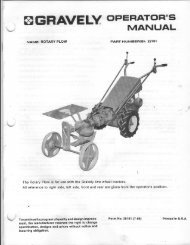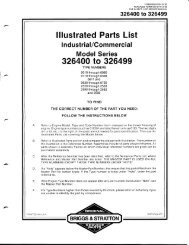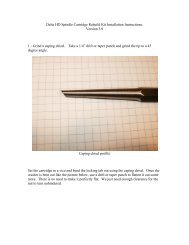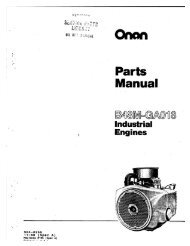272144 Vanguard Twin Cylinder OHV BRIGGS & STRATTON.pdf
272144 Vanguard Twin Cylinder OHV BRIGGS & STRATTON.pdf
272144 Vanguard Twin Cylinder OHV BRIGGS & STRATTON.pdf
You also want an ePaper? Increase the reach of your titles
YUMPU automatically turns print PDFs into web optimized ePapers that Google loves.
Additional Precautions<br />
Before working on the engine, read and understand<br />
the applicable sections of this manual. Follow all<br />
safety warnings. Death, personal injury and/or property<br />
damage may occur unless service instructions<br />
are followed carefully.<br />
DO NOT store, spill, or use gasoline near an open<br />
flame, or near an appliance like a stove, furnace, or<br />
water heater that uses a pilot light or creates a spark.<br />
DO NOT refuel indoors or in an unventilated area.<br />
DO NOT operate or tip engine/equipment at an<br />
angle that causes gasoline spillage.<br />
DO NOT operate engine if gasoline is spilled, when<br />
smell of gasoline is present, or when other explosive<br />
conditions exist. (Move equipment away from spill.<br />
Avoid ignition until gasoline has evaporated.)<br />
DO NOT transport engine with fuel in tank or fuel<br />
shut-off valve open.<br />
DO NOT choke carburetor to stop engine, especially<br />
in an enclosed vehicle. (Gradually reduce engine<br />
speed before stopping.)<br />
DO NOT tamper with governor springs, links or other<br />
parts to increase engine speed. (Run engine at speed<br />
set for equipment manufacturer.)<br />
DO NOT check for spark with spark plug removed.<br />
(Use an approved tester.)<br />
DO NOT run engine with blower housing or other<br />
safety shields removed.<br />
DO NOT crank engine with spark plug removed. (If<br />
engine is flooded, place throttle in FAST position and<br />
crank until engine starts.)<br />
DO NOT strike flywheel with a hammer or hard object.<br />
This could cause the flywheel to shatter in operation.<br />
(Use only Briggs & Stratton approved tools and procedures<br />
to remove the flywheel.)<br />
DO NOT operate engine without a muffler. (Inspect<br />
periodically and replace if worn or leaking. If engine<br />
is equipped with muffler deflector, inspect periodically<br />
and replace if necessary. Replacement parts must be<br />
same as on original equipment.)<br />
DO NOT operate engine with grass, leaves or other<br />
combustible material accumulated in the muffler<br />
area.<br />
DO NOT touch hot muffler, cylinder, or fins which can<br />
cause burns.<br />
DO NOT start engine with air cleaner or air cleaner<br />
cover removed.<br />
DO NOT attempt to start engine with cutting blade<br />
loose or removed. (Blade must be tight, otherwise<br />
kickback may occur.)<br />
DO NOT remove fuel tank cap or fill the fuel tank<br />
while the engine is hot or running. DO NOT refuel indoors<br />
or in an unventilated area. Allow the engine to<br />
cool at least 2 minutes before refueling.<br />
WEAR suitable eye protection (safety glasses,<br />
goggles or face shield) when performing repair procedures.<br />
PREVENT ACCIDENTAL STARTING by disconnecting<br />
spark plug wire from spark plug when servicing<br />
engine or equipment. Disconnect negative wire<br />
from battery terminal if equipped with electric starting<br />
system.<br />
USE ONLY genuine Briggs & Stratton parts or their<br />
equivalent. The use of non-equivalent replacement<br />
parts may damage the engine.<br />
GASEOUS FUEL ENGINES – Check fuel lines and<br />
fittings frequently for cracks or leaks. Replace as<br />
necessary.<br />
5


